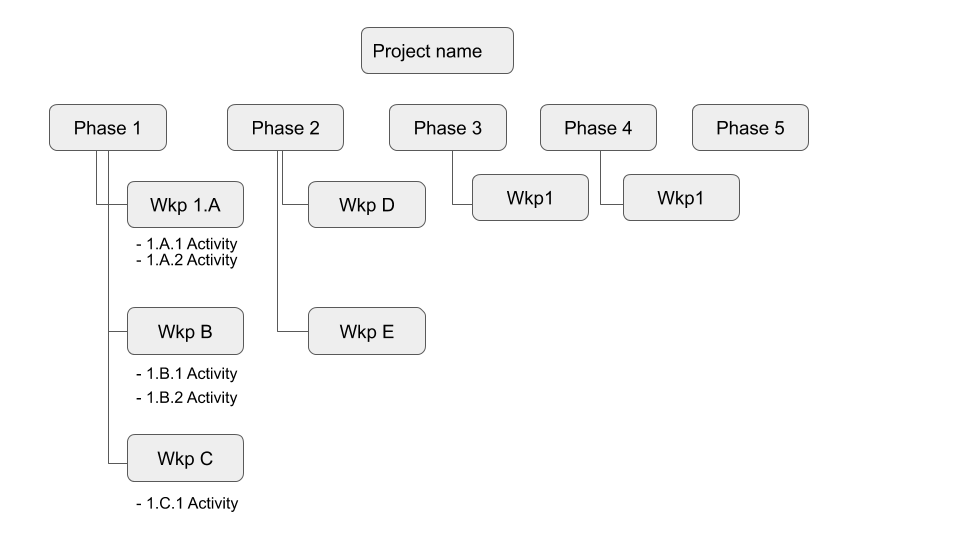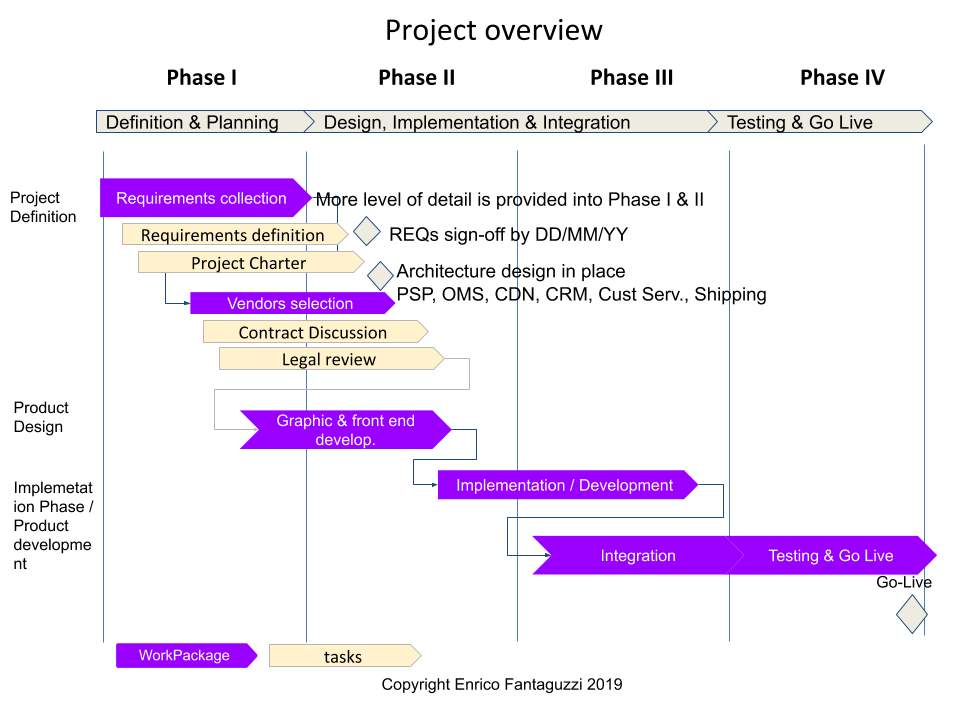For the English version click here

Nell’immagine abbiamo una Work Breakdown Structure organizzata per fasi, in cui le attività in fase 1 sono più dettagliate, cioè hanno una maggiore granularità, delle attività nell fasi successive
L’elaborazione progressiva, o Rolling Wave Planning, consiste nel pianificare a livello molto dettagliato le attività che sono più vicine a noi temporalmente, e pianificare in maniera meno dettagliata le attività che sono più in là nel tempo.
E’ un concetto estremamente logico ed efficiente nell’utilizzo delle risorse. Le attività che sono da svolgere nell’immediato logicamente hanno più informazioni a supporto rispetto ad attività che dovranno svolgersi tra mesi e mesi e che necessiteranno degli output delle attività precedenti (predecessors) per essere implementate.
L’elaborazione progressiva, uno dei concetti chiave nel Agile Project Management, è in realtà un concetto base anche nella metodologia a cascata proposta dal Project Management Institute nel PMBoK
Leggiamo la versione originale tratta dal PMBoK 4th edition e poi la vediamo tradotta in Italiano:
“Because of the potential for change, the project management plan is iterative and goes through progressive elaboration throughout the project’s life cycle. Progressive elaboration involves continuously improving and detailing a plan as more-detailed and specific information and more accurate estimates become available. Progressive elaboration allows a project management team to manage to a greater level of detail as the project evolves.”
Traduzione: per via della possibilità di cambiamento, il piano di gestione di progetto è iterativo e attraversa un’elaborazione progressiva per tutto il ciclo di vita del progetto.
L’elaborazione progressiva implica il miglioramento continuo del piano e l’aggiunta di dettagli al piano man mano che informazioni più dettagliate e specifiche – nonché stime più precise – diventano disponibili.
L’elaborazione progressiva consente al team di progetto di gestire un livello di dettaglio maggiore man mano che il progetto evolve.

Scarica il template gratuito in Powerpoint.
Un esempio reale di rolling wave planning in un meeting di progetto
Poco tempo fa ho partecipato a una riunione di progetto in cui il capo progetto ha illustrato le attività principali dei successivi sei mesi. Gli stakeholder presenti andavano dal CEO ai Key User per cui la difficoltà stava nel trovare un bilanciamento tra la necessità di spiegare nel dettaglio alcune attività e mantenere una visione d’insieme per la direzione. Il risultato è stato che dopo aver presentato e discussione le macro attività di tutto il progetto, siamo entrati nel dettaglio delle attività delle successive sei settimane e non oltre.
Rolling Wave Planning – Agile vs. Waterfall Project Magement
Definizione di Rolling Wave Planning in inglese e italiano commentata
“Rolling wave planning is a form of progressive elaboration planning where the work to be accomplished in the near term is planned in detail and future work is planned at a higher level of the WBS. Therefore, work can exist at various levels of detail depending on where it is in the project life cycle. For example, during early strategic planning, when information is less defined, work packages may be decomposed to the milestone level. As more is known about the upcoming events in the near term it can be decomposed into activities.”
La definizione di rolling Wave Planning tradotta in Italiano significa: Rolling Wave planning è una forma di elaborazione progressiva in cui il lavoro che deve essere svolto nel breve periodo è pianificato ad un livello di dettaglio maggiore mentre il lavoro che dovrà essere svolto più in là nel tempo viene pianificato ad un livello più alto della Work Breakdown Structure che vuol dire un livello minore di dettaglio, (vedi immagine della work break down structure che somiglia ad una tassonomia). Per esempio durante le le fasi iniziali della pianificazione strategica, quando le informazioni a nostra disposizione sono ancora scarse, i work packages (pacchetti di lavoro) possono essere scomposti a livello di milestone (tappa intermedia), man mano che sappiamo di più sui prossimi sviluppi i pacchetti di lavoro possono essere scomposti a livello di attività.
Work BreakDown StructureVediamo un esempio. Se devo costruire una casa e supponiamo che il progetto richieda tre anni, potremmo avere come ipotesi:
- 4 fasi: analisi costi benefici, progettazione, costruzione, collaudo.
- Work packages: Analisi Tecnica, Analisi Finanziaria, Gestione autorizzazioni; Progettazione; Acquisto materiali; Costruzione; Gestione lavori; Finalizzazione.
- 10 -15 milestones (tappe intermedie): Fase1: 1.1 stime costi completata, 1.2 analisi ritorno sull’investimento completata; Fase 2: 2.2 team di progetto arruolato; 2.3 analisi geologica completata; 2.4 disegno completato; 2.5 capitolato completato; 2.6 permessi ottenuti; Fase3: 3.1 acquisto materiali, 3.2 scavi completati; 3.3 Costruzione struttura perimetrale completata; 3.4 Finiture; 4: 4.1 collaudo; 4.2 ottenimento abitabilità.
- Activities: reclutamento architetto e altri professionisti; creazione documento di requisiti; analisi costi di progettazione; analisi costi di costruzione; richiesta permessi; ….
Ho preso un esempio che possa essere comprensibile per tutti, ma non essendo del settore edilizio mi scuso per eventuali imprecisioni in anticipo.
Il rolling wave planning è un approccio alla pianificazione delle attività di progetto, in cui le attività più vicine a noi temporalmente, vengono analizzate ad un livello maggiore di dettaglio, mentre le attività più lontane nel tempo vengono pianificate ad un livello più alto della WBS ovvero con meno dettagli.
Questo concetto che è stato adottato poi dalla disciplina Agile, è un concetto appartenente alla metodologia PMI a cascata (waterfall o sequenziale).
Capiamo quindi che la critica alla metodologia a cascata di essere rigida e richiedere troppa analisi iniziale è quindi infondata, il problema è in realtà la conoscenza non approfondita della metodologia che causa la rigidità nell’applicazione della stessa.
In altre parole sia l’approccio suggerito dal PMI sia la metodologia Prince2 hanno in sè tutti gli strumenti concettuali per garantirne l’applicazione in contesti diversi e per adattarsi alle varie realtà aziendali. La scarsa conoscenza delle metodologie da parte dei Project Manager e dei Responsabili dei PMO rende la loro applicazione in azienda inefficace.
L’applicazione di una metodologia agile, che di per sè non impone di darsi delle tempistiche definite per le attività, dà la sensazione di minore rigidità. Questa sensazione di minor rigidità non garantisce però il rispetto di tempi e costi che in molti casi possono essere dei fattori determinanti per il successo dei progetti.

Leave a Reply